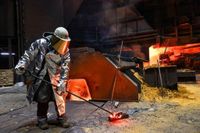The European Union set the global steel industry abuzz on Tuesday, October 7, 2025, as it unveiled a sweeping proposal to slash its tariff-free quota for steel and steel products by nearly half—a move that could have dramatic consequences for both European and British manufacturers. Under the plan, any steel imports above a new quota of 18.3 million tons would face a hefty 50% tariff, doubling the previous 25% rate and matching the hardline approach famously taken by former U.S. President Donald Trump. The measure, announced by the European Commission, is aimed at shielding Europe’s struggling steelmakers from a deluge of cheap imports and the growing threat of global overcapacity. But it’s also sending shockwaves across the Channel, with UK industry leaders warning of an existential crisis.
The European Commission’s proposal, which still needs to clear the European Parliament and Council, would impact major exporters to the EU—including China, India, Turkey, and the United Kingdom. Neighboring countries such as Norway, Iceland, and Ukraine, however, would be exempt from the new restrictions. According to Bloomberg, the quota reduction is roughly 45%, and the new tariff rate mirrors the protectionist measures the United States adopted several years ago. The proposal replaces an existing steel safeguard policy, aligned with World Trade Organization (WTO) rules, that is due to expire in June 2026.
European Commission President Ursula von der Leyen did not mince words about the stakes. “A strong, decarbonized steel sector is vital for the European Union’s competitiveness, economic security and strategic autonomy. Global overcapacity is damaging our industry,” she declared, underscoring the urgency of the move. The numbers help explain the concern: The European Steel Association estimates that global steel overcapacity now stands at a staggering 602 million tonnes—four times the EU’s total annual consumption. In 2024 alone, the EU exported 77 billion euros (about $89.7 billion) and imported 73.1 billion euros (about $85.2 billion) worth of steel, according to Eurostat.
To prevent a flood of redirected imports—especially as high American tariffs continue to bite—the EU’s new system would require steel importers to clearly declare where their products were melted and poured. A complex quota mechanism would then govern what is allowed into the massive EU common market. Stéphane Séjourné, the European Commission’s executive vice president for industrial strategy, hailed the proposal as a cornerstone of Europe’s industrial renewal, posting on X, “This is the new safeguard clause on steel. This is the reindustrialization of Europe.”
But not everyone is celebrating. The UK, whose steel industry is already on the ropes, has been particularly rattled by the announcement. More than three-quarters of British steel exports are destined for the EU, leaving the sector highly exposed. Gareth Stace, Director-General of UK Steel, sounded the alarm: “This is perhaps the biggest crisis the U.K. steel industry has ever faced.” He called on the British government to pull out all the stops to secure special quotas for the UK, warning that failure could spell disaster. Stace also cautioned that the EU’s move risked “redirecting millions of tonnes of steel towards the U.K.” from countries hit by the new tariffs, a scenario he said “could be terminal for many of our remaining steel companies.”
Prime Minister Keir Starmer attempted to calm nerves, confirming that the UK is “in discussions with the EU” about the proposal. “I’ll be able to tell you more in due course but we are in discussions, as you’d expect,” he told reporters. Still, the timing could hardly be worse for Britain’s once-mighty steel industry, which has shrunk dramatically since its heyday in the 1970s and now accounts for just 0.1% of the UK economy. Thousands of jobs are already at risk at the country’s biggest steelworks, Port Talbot in Wales, as its owner Tata Steel seeks to make the loss-making plant both leaner and greener.
The trade union Community, which represents many steelworkers, called the EU’s proposal “an existential threat to our steel industry.” Alasdair McDiarmid, the union’s Assistant General Secretary, emphasized that “global overcapacity is a shared challenge and it is in both the UK and the EU’s interests to work together to find a solution.” He warned that “a trade war, at what is already a turbulent time for the global steel industry, would be incredibly damaging for everyone involved, with workers in the U.K. and Europe paying the heaviest price.”
Judith Kirton-Darling, general secretary for the trade union bloc IndustriAll’s Europe office, echoed these concerns at the Emergency Steel Social summit in September: “Steel is the backbone of Europe’s economy, yet the sector is now at breaking point. That is why trade unionists from every corner of Europe have joined steelmakers at this summit to call for urgent action.” The numbers back her up: Steel manufacturers still employ about 300,000 people across 20 of the EU’s 27 member states, but the sector has lost roughly a quarter of its workforce over the past two decades, according to Eurostat.
The EU’s steel sector is more than just an economic pillar; it’s a symbol of European unity. The very roots of the modern EU can be traced to the 1951 European Steel and Coal Community, which bound together Luxembourg, Italy, France, the Netherlands, West Germany, and Belgium in a common market for these vital resources. Now, as the continent faces a new era of industrial and geopolitical uncertainty, the fate of steel is once again at the center of the European project.
Internationally, the ramifications could be far-reaching. The United States and the EU have been negotiating a “ring-fencing” approach to steel tariffs, aiming to secure supply chains for both economic giants. Yet, a comprehensive agreement covering products like whisky, wine, and steel remains elusive. The new EU proposal could add another layer of complexity to these talks. EU trade representative Maroš Šefčovič confirmed that the steel tariffs and quotas will be a key topic at the upcoming G20 trade ministers’ meeting in South Africa on Friday, October 10, 2025.
As the debate rages, one thing is clear: the EU’s bold move has ignited fresh tensions and forced a reckoning over the future of steelmaking on both sides of the Channel. Whether it will ultimately shore up Europe’s industrial base or trigger a damaging trade war remains to be seen, but the stakes for workers, companies, and governments could hardly be higher.






